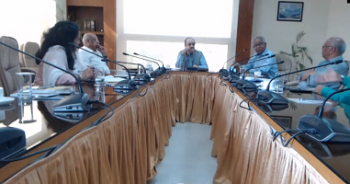VIF held a discussion with domain experts on the above theme.
On the morning of 9 July 2022, Sri Lanka woke upto finding its citizens out in the streets not only in Colombo but all of its major cities. For a country that has struggled through ethnic stride, the social and political outbursts were first of its kind the nation witnessed in recent decade. The dire economic conditions that caused unprecedented shortage of food including milk and medicines and basic amenities led to over 100,000 Sri Lankans storming the Presidential Palace of Sri Lankan President Gotabaya Rajapaksa while another set of protestors set Prime Minister Wickremesinghe’s private house on fire. The violence and outburst forced the President to stepping down. On July 20, Sri Lankan MPs chose Wickremesinghe to lead the island nation as President. The Sri Lankan President Ranil Wickremesinghe has invited members of Parliament to establish an all-party national administration. He has proposed plans to implement a “systematic economic programme" that would have included all political parties with representatives in Parliament, academic institutions, and civil society.
It is within this background that a discussion at VIF was held amongst experts on the political developments in Sri Lanka and Indian choices.
It was pointed out while people had voiced their grievances against the Gotabaya government very strongly, some of the other younger Gotabaya family members continued in their positions. The SLPP party continued to wield considerable power over Ranil. And even in the eventuality of an all-party government forming, Gotabaya will also continue be in position to influence decisions.
In the post emergency phase Ranil who has general acceptability will be able to introduce a modicum of stability which is already visible. The LPG is now available, fuel stations chaos has reduced following introduction of the QR code system, power situation has improved but continues to be a matter of concern. There are positive indications in other sectors, buthe will be restrained in many of this measures he may wish to introduce. The Samagi Jana Balawegaya has lent their support to Ranil and has also suggested opening a discussion with interested parties about reintroducing the 19th Amendment to the Constitution, but these are difficult issues to grapple with.
The economy turn around will not be easy. The IMF bailout has not helped in the past but its ability to restructure the debt will be difficult. Sri Lankans have been pampered by each government through tax cuts, subsidies etc over the years.
Following from that the question that arises is how far is India willing to prop up this Sri Lankan government?
India
In Ranil’s speech at the Parliament on 3 Aug, he devoted several minutes talking about India and it was exceptional as no other country was mentioned directly or indirectly. Wickremesinghe has made two important statements on Sri Lanka-India relations. On Aug 14, he was present at a ceremony in Colombo to witness the handing over of an Indian Dornier Maritime Recce and Surveillance Aircraft to the Sri Lankan Navy, where he reflected on Indo-Lanka relations too.
As is known, in the wake of the dire conditions, Sri Lanka has received substantial support from India who committed to more than $4 billion to debt-ridden Sri Lanka in loans, credit lines and credit swaps since early 2022. There is recognition of India’s backing, and most understand and few have publicly admitted, that India has come in a big way with a package to help Sri Lanka. If not for Indian assistance with fuel supplies on credit, Sri Lanka’s situation would have been even worse.
The road ahead for India looks difficult. There is no pro-India constituency in Sri Lanka. The Janatha Vimukthi Peramunaparty that has always referred to India as an expansionist power, now admits that India is not the enemy. But SL still remembers the support India lent to the Tamils. For now an Indian public signalling is important and its ability to offer lines of credit quickly conveyed a distinct message. But India’s ability provide constant succor to Sri Lanka is limited. Many of the Indian previous proposals including the connectivity project and bilateral energy grid remains unimplemented.
India will have to follow a policy of close engagement but not play favourites. While there is no pervasive anti-India sentiment, the Sinhala Buddhist political constituency uses that narrative to demonise India. It is known that Sri Lanka has not been sensitive to India’s security concerns, it is critical India convey that that point across to them and reiterate the concerns as well as convey the red lines.
India needs to increase the people to people connectivity as well build infrastructural connectivity. In the recent past the Sri Lankan High Commissioner to India had highlighted a ten point agenda to increase the bilateral engagement; it will be worthy examining them again. India could focus on the developing the Buddhist Bodh Gaya travel circuit, this would have immediate appeal to a large population in Sri Lanka.









Post new comment